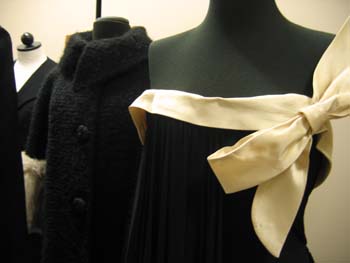Power and Pragmatism: Beyond the Little Black Dress
Monday, October 12, 2009 to Friday, November 6, 2009
Austerity, rebellion, anonymity, power and allurement. These are among the themes presented in the exhibit Power and Pragmatism: Beyond the Little Black Dress in the Robert Hillestad Textile Gallery of the Department of Textiles, Clothing and Design at the University of Nebraska-Lincoln. The department will unveil its newly renovated gallery and showcase its historic costume collection in an exhibit of black clothing curated by Dr. Barbara Trout. The exhibit includes 48 garments, the earliest being a lace dress from the late 1860’s, and the newest, a sweater designed in 1983 by Japanese deconstructionist fashion designer Rei Kawakubo.
The process of pulling together a large group of black garments including but not limited to the “little black dress” results in several messages on the subject of dress and adornment. The grouping points out the practical, conservative nature of Nebraska dress in the late 19th and early 20th centuries. The 48 garments in the exhibition represent only a small portion of the total number of black garments in the collection. When grouped together they supply evidence of the refined cut and sculptural quality of black dress in relation to the body. Limiting the selection to black allows the viewer to read the depth and richness of the fabrics as well as to focus on the wide range of surface treatments used on the garments. These include beadwork, appliqué and tunnel stitching. Conservative many of the items are, functioning as garments for work, for exercise and for mourning. The variety of types of garments span over a hundred years and reveal various meanings. City dwellers’ dress bridges day and night; the anti-fashion statements of young designers challenge conservative notions of propriety.
An exhibit of this depth is really only possible because of the donors who make a conscious decision to preserve important items of dress by donating these item to UNL’s Textiles Clothing and Design collection, housed in the College of Education and Human Sciences. One such donor is Katie Best of Omaha, some of whose garments are included in the exhibition. She is a long time collector and member of the Costume Society of America. Although the exhibit explores the range of motives for wearing black, it will include several renditions of not only the “little black dress” but the “powerful black suit”. One example is a rich velvet shirt dress by Anne Fogarty, donated by the late Mary Louise Babst, one of Lincoln’s beloved fashion authorities. Another donor, Mrs. Thomas (Marjorie) Woods, has played a significant role in building the late 20th century part of the historic costume collection. The 1960 designers represented in her donations include Pierre Cardin and Norman Norell. James Galanos will be represented thanks to donations from Joan Furr. Other garments of note are a wool swimming suit from the 1890’s and a rare lace jacket featuring pagoda sleeves and botanical motifs. This range of garments explores concepts related to the roles that dress plays in embodying uniformity on the one hand, and individuality on the other.
An opening reception and public lecture is scheduled for Wednesday, October 14th at 6:30 and will feature commentary on the power of wearing black presented by Trout and Dr. Harriet McLeod. Exciting original garments by students of the department will be modeled. Guests are encouraged to pull their favorite black attire from their closets and come dressed in black.
|
Close-up of Chiffon Gown and 1960's Coat |
Grouping of Garment in Collections Room |
Close-up of Brocade and Beaded Garment |



